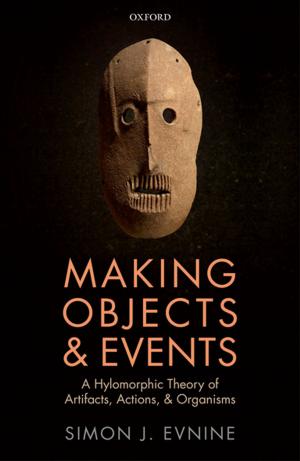From Elvish to Klingon
Exploring Invented Languages
Nonfiction, Reference & Language, Language Arts, Linguistics| Author: | ISBN: | 9780191631610 | |
| Publisher: | OUP Oxford | Publication: | October 27, 2011 |
| Imprint: | OUP Oxford | Language: | English |
| Author: | |
| ISBN: | 9780191631610 |
| Publisher: | OUP Oxford |
| Publication: | October 27, 2011 |
| Imprint: | OUP Oxford |
| Language: | English |
How are languages invented? Why are they invented? Who uses them? What are the cultural effects of invented languages? This fascinating book looks at all manner of invented languages and explores the origins, purpose, and usage of these curious artefacts of culture. Written by experts in the field, chapters discuss languages from Esperanto to Klingon and uncover the motives behind their creation, and the outcomes of their existence. Introduction by Michael Adams Linking all invented languages, Michael Adams explains how creating a language is intimidating work; no one would attempt to invent one unless driven by a serious purpose or aspiration. He explains how the origin and development of each invented language illustrates inventors' and users' dissatisfaction with the language(s) already available to them, and how each invented language expresses one or more of a wide range of purposes and aspirations: political, social, aesthetic, intellectual, and technological. Chapter 1: International Auxiliary Languages by Arden Smith From the mythical Language of Adam to Esperanto and Solrésol, this chapter looks at the history, linguistics, and significance of international or universal languages (including sign languages). Chapter 2: Invented Vocabularies: Newspeak and Nadsat by Howard Jackson Looking at the invented vocabularies of science fiction, for example 1984's 'Newspeak' and Clockwork Orange's 'Nadsat', this chapter discusses the feasibility of such vocabularies, the plausibility of such lexical change, and the validity of the Sapir-Whorfian echoes heard in such literary experiments. Chapter 3: 'Oirish' Inventions: James Joyce, Samuel Beckett, Paul Muldoon by Stephen Watt This chapter looks at literary inventions of another kind, nonsense and semi-nonsense languages, including those used in the works of James Joyce and Samuel Beckett. Chapter 4: Tolkien's Invented Languages by Edmund Weiner Focussing on the work of the accomplished philologist J.R.R. Tolkien, the fifteen languages he created are considered in the context of invented languages of other kinds. Chapter 5: Klingon and other Science Fiction Languages by Marc Okrand, Judith Hendriks-Hermans, and Sjaak Kroon Klingon is the most fully developed of fictional languages (besides Tolkien's). Used by many, this chapter explores the speech community of 'Trekkies', alongside other science fiction vocabularies. Chapter 6: Logical Languages by Michael Adams This chapter introduces conlangs, 'constructed languages'. For example, Láaden, created to express feminine experience better than 'patriarchal' languages. Chapter 7: Gaming Languages and Language Games by James Portnow Languages and games are both fundamentally interactive, based on the adoption of arbitrary sign systems, and come with a set of formal rules which can be manipulated to express different outcomes. This being one of the drivers for the popularity of invented languages within the gaming community, James Portnow looks at several gaming languages and language games, such as Gargish, D'ni, Simlish, and Logos. Chapter 8: Revitalized Languages as Invented Languages by Suzanne Romaine The final chapter looks at language continuation, renewal, revival, and resurrection - in the cases of Gaelic, Welsh, Cornish, and Breton - as well as language regulation.
How are languages invented? Why are they invented? Who uses them? What are the cultural effects of invented languages? This fascinating book looks at all manner of invented languages and explores the origins, purpose, and usage of these curious artefacts of culture. Written by experts in the field, chapters discuss languages from Esperanto to Klingon and uncover the motives behind their creation, and the outcomes of their existence. Introduction by Michael Adams Linking all invented languages, Michael Adams explains how creating a language is intimidating work; no one would attempt to invent one unless driven by a serious purpose or aspiration. He explains how the origin and development of each invented language illustrates inventors' and users' dissatisfaction with the language(s) already available to them, and how each invented language expresses one or more of a wide range of purposes and aspirations: political, social, aesthetic, intellectual, and technological. Chapter 1: International Auxiliary Languages by Arden Smith From the mythical Language of Adam to Esperanto and Solrésol, this chapter looks at the history, linguistics, and significance of international or universal languages (including sign languages). Chapter 2: Invented Vocabularies: Newspeak and Nadsat by Howard Jackson Looking at the invented vocabularies of science fiction, for example 1984's 'Newspeak' and Clockwork Orange's 'Nadsat', this chapter discusses the feasibility of such vocabularies, the plausibility of such lexical change, and the validity of the Sapir-Whorfian echoes heard in such literary experiments. Chapter 3: 'Oirish' Inventions: James Joyce, Samuel Beckett, Paul Muldoon by Stephen Watt This chapter looks at literary inventions of another kind, nonsense and semi-nonsense languages, including those used in the works of James Joyce and Samuel Beckett. Chapter 4: Tolkien's Invented Languages by Edmund Weiner Focussing on the work of the accomplished philologist J.R.R. Tolkien, the fifteen languages he created are considered in the context of invented languages of other kinds. Chapter 5: Klingon and other Science Fiction Languages by Marc Okrand, Judith Hendriks-Hermans, and Sjaak Kroon Klingon is the most fully developed of fictional languages (besides Tolkien's). Used by many, this chapter explores the speech community of 'Trekkies', alongside other science fiction vocabularies. Chapter 6: Logical Languages by Michael Adams This chapter introduces conlangs, 'constructed languages'. For example, Láaden, created to express feminine experience better than 'patriarchal' languages. Chapter 7: Gaming Languages and Language Games by James Portnow Languages and games are both fundamentally interactive, based on the adoption of arbitrary sign systems, and come with a set of formal rules which can be manipulated to express different outcomes. This being one of the drivers for the popularity of invented languages within the gaming community, James Portnow looks at several gaming languages and language games, such as Gargish, D'ni, Simlish, and Logos. Chapter 8: Revitalized Languages as Invented Languages by Suzanne Romaine The final chapter looks at language continuation, renewal, revival, and resurrection - in the cases of Gaelic, Welsh, Cornish, and Breton - as well as language regulation.















